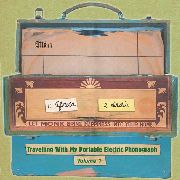
Various
Travelling With My Portable...
...Electric Phonograph, Vol. 1". What did South Africa and South East Asia of the 1940s and 50s have in common? In both places the local population was trying to gain independence from British colonialism. Although colonialism is never a good thing, there are always some positive outcomes when two cultures collide, especially when it comes to music. The Zulu of South Africa are the largest ethnic group in the country and are well known for their rich musical traditions. In the 1940s, however, Zulu musicians began fusing traditional Zulu choral music (often sung by migrant mine workers), like Mbube and Isicathamiya, with the instruments and rhythms of Western jazz. A continent away in India, we see that the same kind of musical revolution was taking place during this same period. Calcutta in particular became a musical hotbed beginning in WWII, when it became one of the major ports for the South East Asian Theatre of the War. The jazz scene was mainly centred on the house bands from the various luxury hotels and British social clubs, with these bands often recording for the South East Asian division of E.M.I. Interestingly, one of the hottest stars on this scene during the 1940s was Teddy Weatherford, an African American expat from the Chicago jazz scene. Beginning in 1942, following the Japanese invasion of Burma (Myanmar), hundreds of thousands of refugees poured into India, among these great jazz musicians like Reuben Solomon (of Iraqi Jewish descent) of The Rangoon Gymkhana Club fame. Batuk Nandy, on the other hand, was a well-known steel guitar player who rose to fame by making "filmi" music for Bollywood films, while Bismillah Khan was an Indian shehnai (a traditional flute-like instrument) master, and one of only three classical musicians to have ever won the Bharat Ratna prize, the highest civilian prize in India. Khan was also one of the few musicians to perform at Delhi's Red Fort in 1947 for India's Independence celebrations. Despite the obvious negative outcomes, different cultures and religions forced together in the face of economic and political adversity has historically been a recipe for great music, and as this album testifies, India and South Africa were no different. Tracks: - Side A - AFRICA: 1. CASPER SHIKI & his Guitar - Umtandaso (Zulu guitar jive) 2. LATIN STARS - Sarah (vocal group + guitar, Zulu jive) 3. LATIN STARS - Umama Ulethu Shugela (vocal group + guitar, Zulu jive) 4. NYASALAND CLUB SINGERS - Kapasure (vocal with guitar and accordion, sung in Chichewa, South-Central Africa) 5. CASPER KASINO KIDS - Ungu Wam (female vocal trio + piano, Zulu jive) 6. CASPER KASINO KIDS - Thula Thula (female vocal trio + piano, Zulu jive) 7. DOROTHY MASUKA with her Trio (Zulu) - Ma Ndi Phupha Wena - Johannesburg autumn 1953 (blues vocal + piano, clarinet) 8. GROUPO DE TOTOKO FRANCAIS - Bololo o Kolilo (Recorded in Kimongo, Republic of Congo c. 1940s) 9. MAMETIGUDI & HIS DANCERS - Hamba Na Lo Isoko La Yo (Zulu vocal with drums and sticks c. 1950) Side B: - INDIA: 1. THE RANGOON GYMKHANA CLUB ORCHESTRA - My Melancholy Baby (Norton-Burnett) Calcutta, c. 1940 2. TEDDY WEATHERFORD & his Band - Hoe Down (Calcutta, May 11, 1942) 3. TAJ MAHAL HOTEL DANCE ORCHESTRA - Chattanooga choo choo (Gordon-Warren) Calcutta, May 1942 4. REUBEN SOLOMON & his Jive Boys - Constantly (Calcutta, January 1943) 5. MAURICE ARNOLD & his Jive Boys - Doggin around (Basie-Arnold) Calcutta, 1945 6. BATUK NANDY (Electric Guitar) - Instrumental film music (Calcutta, 1960s) 7. A.RAHMAN & COLUMBIA ORCHESTRA - Oh, Juita Ku (Dengan, Malaya, 1949) 8. BISMILLAH KHAN & PARTY - Shenai instrumental (India c. 1949).